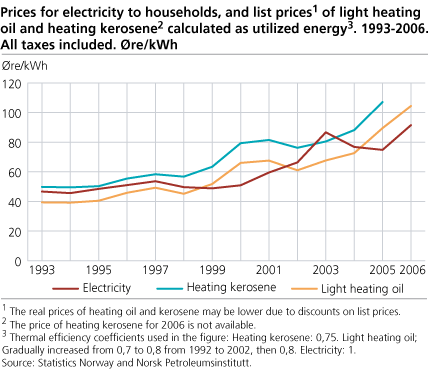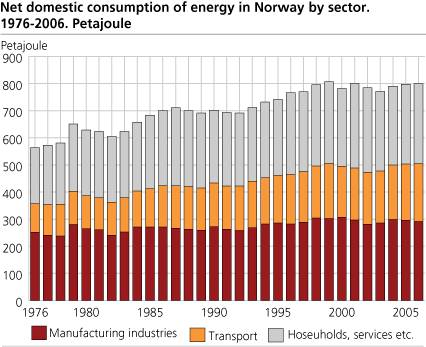Content
Published:
This is an archived release.
More energy to transport
Record high electricity prices and shut downs in some large enterprises affected the development in energy consumption in 2006. This contributed to a drop in electricity consumption in 2006 compared to the previous year, while petroleum products to transport and heating rose.
The consumption of electricity in 2006 was 2.4 per cent lower than in the previous year, while the use of oil products rose by 3.5 per cent. Increased use of oil compensated for the drop in electricity use, and the total energy consumption was almost unchanged from 2005, at around 222 Terawatt hours (TWh). However, consumption for different purposes changed. While the total energy consumption for heating, lighting, manufacturing etc. fell by 1 per cent from 2005, the energy consumption for transport rose by 3 per cent.
Higher energy consumption within transport
During the period 1997 - 2006 the total energy consumption for transport purposes rose by 14 per cent, while consumption for other purposes only rose by 1 per cent. This indicates that while we have achieved more efficient energy consumption for stationary purposes, it has been more difficult to limit the growth in consumption for transport. On the contrary, more goods transport, holidays, commuting and other job travelling contributes to higher energy consumption related to this. Energy to transport purposes made up 27 per cent of the energy consumption in 2006, while the corresponding figures in 1980 and 1990 were 19 and 23 per cent respectively. Transport consumption makes up more than a third of our total CO2 emissions.
More use of biodiesel
Use of biodiesel is one possible effort to limit the harmful CO2 emissions from vehicles. The use of biodiesel is still low in Norway, although it has increased in recent years. In 2006 the sale of biodiesel made up 7.1 million liters, that is a doubling from the previous year.1 About 3 per cent of the total quantity of sold diesel was mixed with biodiesel in 2006. Maximum 5 per cent biodiesel is mixed in the diesel, to make sure that all cars tolerate this. Measured as pure biodiesel, this made up 0.3 per cent of the total diesel sale. E85, which is bioethanol mixed with 15 per cent gasoline, was also sold in 2006. This made up only a few per thousand of the total sale of gasoline.
Record high electricity prices and lower electricity consumption
The electricity consumption in households and the service sector fell by about 1 per cent from 2005, but more use of heating oil implied that the total energy consumption in this sector was about the same as the previous year. In 2006, the households paid 91.5 øre/kWh on average, that is 5 øre more than in 2003, the last time the electricity prices peaked.
Lower energy consumption in manufacturing industries
Higher electricity prices is also an incentive to limit electricity consumption for the manufacturing industries, by using more steam or installing heat recovery systems etc. In manufacturing industries, the electricity consumption fell by 4 per cent from the previous year. The largest decline was in electricity intensive industries, with a drop on 5 per cent from 2005, corresponding to about 1.8 TWh. Traditionally, these enterprises have benefited from having long-term power contracts, but some of these contracts expired in 2006. This contributed to lower profit and shutdowns of some of the enterprises. The electricity intensive industry consists of about 50-55 big enterprises within metal and chemical production that make up about one third of the total electricity consumption in Norway. This corresponds almost to the households' total consumption of electricity. The manufacturing industries used somewhat more natural gas and oil products than in 2005, but nevertheless their total energy consumption fell by scarcely 2 per cent from 2005.
Less crude oil, more natural gas
Norway was the third largest exporter of crude oil in 2005, and is gradually becoming an important exporter of natural gas. Since 2001, the production of crude oil has fallen compared with previous years, while the production of natural gas has increased. This was also the case in 2006. The production of crude oil, condensate and NGL made up about 131 million tonnes, that is 7 per cent less than in 2005. The production of natural gas reached a new record level, with 92 billion Sm3. In total, the oil and gas production fell by 3 per cent from 2005.
Polluting gas power on the continental shelf
Most oil and gas fields produce electricity from natural gas for their own use. According to a survey carried out by the Norwegian Petroleum Directorate, this electricity consumption made up about 7 TWh in 2006. In addition, they generate 8-9 TWh of mechanical energy from natural gas. Due to uncertainty around the size of the electricity production, this is recorded as use of natural gas in the energy balance, not electricity. The total consumption of natural gas on the continental shelf made up about 53 TWh in 2006, which corresponds to about one quarter of the total energy consumption outside the energy sectors. The electricity consumption on the shelf is less efficient and causes more pollution per produced kWh than a modern gas power plant on the mainland would have done, or if the power was transferred from a hydro power plant from the mainland.
Since the mid 1990s, one field has got electricity from the mainland. This, together with extensions in some gas terminals has contributed to a heavy growth in the electricity consumption in oil and gas activity (outside their own power production on the fields) over the last years. According to the NVE (Norwegian Water Resources and Energy Directorate), another field will also be supplied with electricity from the mainland through a sea cable, and this may also be relevant for other platforms. This implies that there is a need for higher electricity production on the mainland. The planned energy plant on Mongstad is supposed to cover some of the increased energy need for the oil and gas activity.
1 Corrected 22 June 2007 at 12:35 p.m.Tables:
- Table 1 Energy sources balance sheet for Norway. 2006
- Table 2 Energy sources balance sheet for Norway. 2005
- Table 3 Energy balance sheet for Norway. 2006. Petajoule
- Table 4 Energy balance sheet for Norway. 2005. Petajoule
- Table 5 Net consumption of individual energy bearers. 1976-2006
- Table 6 Total supply and use of energy. 1997-2006. GWh
- Table 7 Supply and use of electricity 1997-2006. GWh
The statistics is now published as Production and consumption of energy, energy balance and energy account.
Additional information
The statistics are published in spring and autumn. The spring publication is preliminary and aggregated to a larger degree, and only includes figures for energy balance. In the autumn publication, tables are also presented for the energy accounts.
Contact
-
Statistics Norway's Information Centre
E-mail: informasjon@ssb.no
tel.: (+47) 21 09 46 42


